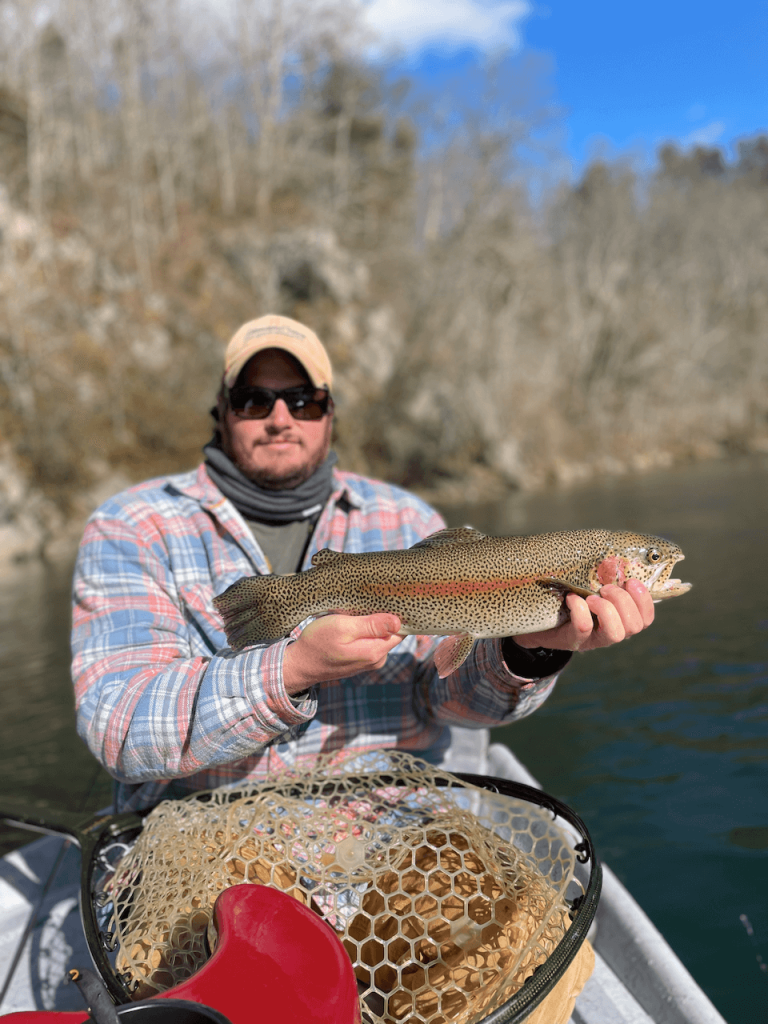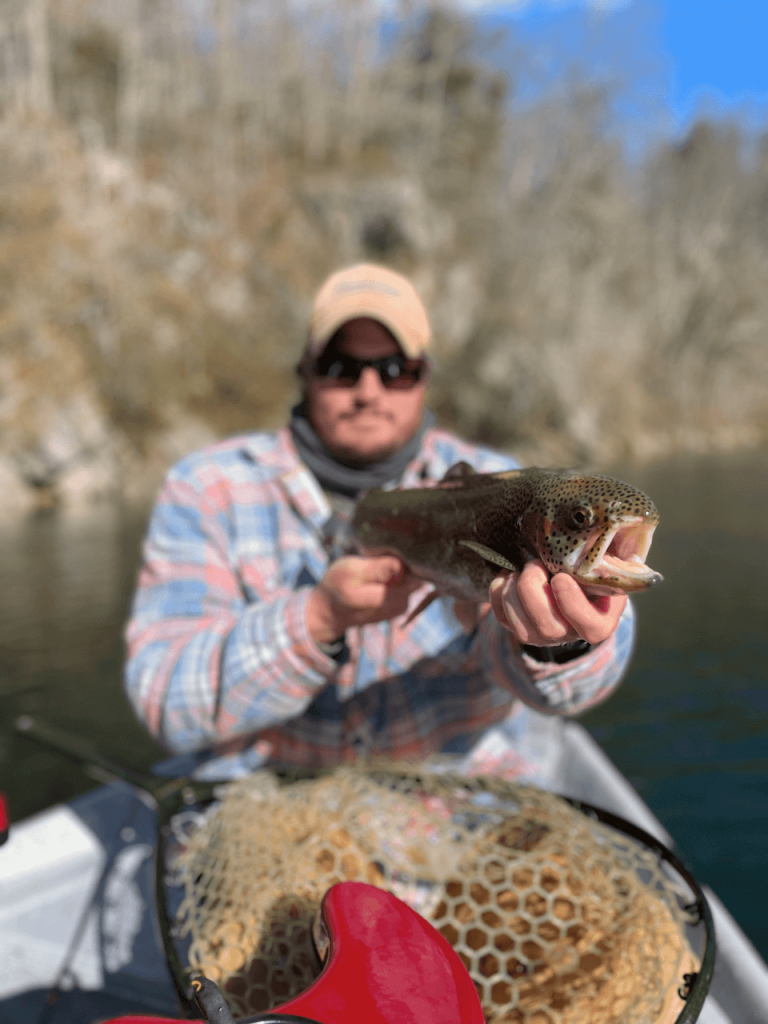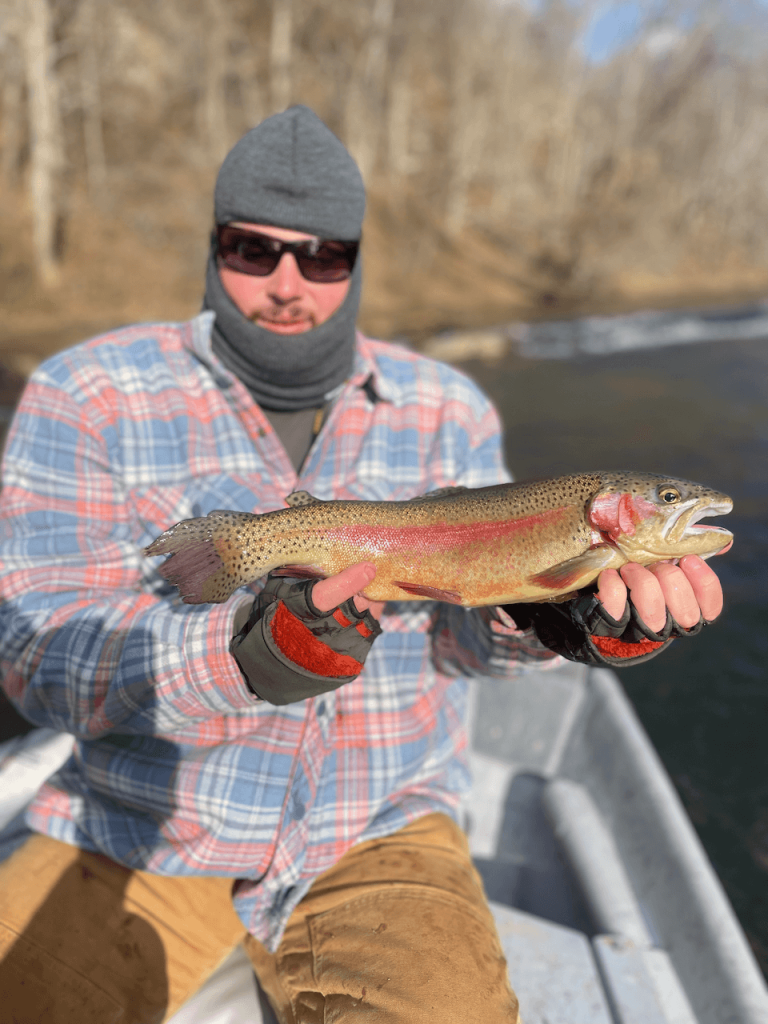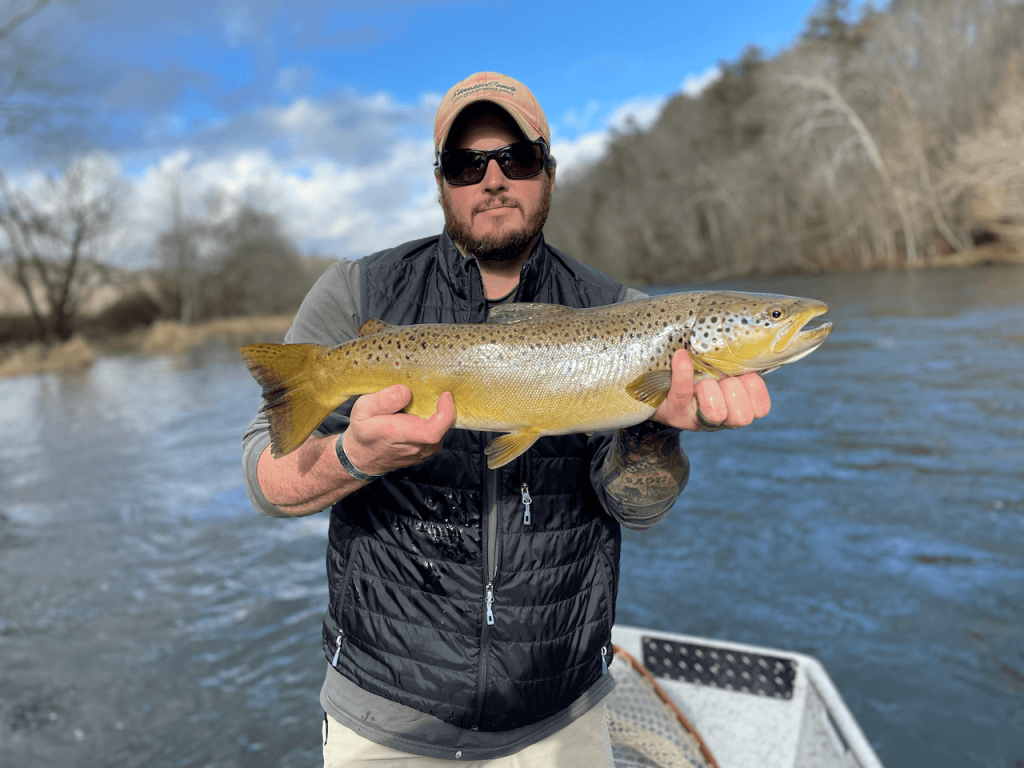Trout Fishing in Winter: 8 Tips and Tricks

Trout fishing in winter can be an incredibly rewarding experience, despite the colder temperatures and the more challenging conditions. However, with our 8 practical tips and tricks for committed anglers, it will become downright easy to secure that winter trout catch. From selecting the right gear and flies that trout can’t resist, to different techniques and the best places for finding fish, our guide will help you go into battle prepared for the ultimate trout-catching adventure this winter.
No matter what kind of idea you have about fly fishing in the winter, we hope to give you a variety of reasons why you should get out there and wet a line this winter. So get your rig ready, set out all your layers, and watch some winter fly fishing videos on YouTube to get you pumped up and ready to make those winter fly fishing dreams come true!
1. Slow things down
The colder temperatures during the winter can cause the trout to become sluggish, so patience here is key. Most of the aggressive fish that we see in summer aren’t so eager to go after those bigger, faster bait fish in the winter. Fish are trying to conserve as much energy as possible here. They aren’t enticed by those fast retrieves you used in the summer to pull a big brown from under a bank. Some of the best anglers I know lose out because of this simple fact. Everything about winter fishing slows down; so should your presentation and fishing tactics.
2. Look for deeper & slower water
Trout often move to deeper water during the winter months, making them more difficult to find. During the warmer and rainier months, flows are typically healthier in the bodies of water trout live in. This provides deeper holes in typically shallow rivers. Without consistent rainfall or snow melt, those deeper pools you fish in summer tend to go away. The fish then move to the other deeper sections that they can find in the river. This shift is caused by several external factors.
The decreasing temperature of the surface water makes trout seek out colder depths and water temperatures that suits their preferences. Trout are also looking for safety from predators. The depth of the water gives them extra protection from birds of prey and other predators. Trout also tend to search for areas with higher oxygen concentrations as the winter approaches. These areas are typically found in deeper parts of the river. Trout are looking for any food they can find during the winter. Most of the time they can find theses food sources in those deeper pools.
3. Think Small
During colder weather, trout tend to be less active, swimming with less energy and expending fewer calories than during other times of year. To conserve energy, trout look for food requiring as little effort as possible, so trout generally opt for smaller flies like a nymph, that are more easily attained. The trout’s essentially slower metabolism yields an opportunity for anglers – bringing smaller flies can lead to more success when trout fishing this time of year.
You not only want to size down in your fly selection, but also with your leaders and tippet size. Typically, during the winter months, the water is much clearer because of the lack of rainfall that pushes dirt and sediment into the rivers. Because of this, it means that rivers are typically clearer. While this helps us with sight fishing, it also helps the trout be able to see better as well.

You’ll want to use a lighter leader and tippet size in the winter months. Anywhere from 5-7x will be sufficient here. Rod and reel size doesn’t really matter as much here either. We typically tell beginners to invest in a 9 foot 5 weight rod and reel. This is really the best all around size combo.
4. Fish Tailwater Stretches
Tailwater rivers are always a great bet for a consistent trout bite. These waters typically house healthier trout populations because of the consistency of the water temperature and food sources. Especially when the dams are bottom fed. During the colder months, the trout tend to school together in deeper pools where the warm groundwater seeps in. This allows anglers to potentially find a larger amount of trout for their effort. Furthermore, trout in tailwaters are often larger and more aggressive because of a more consistent food supply and water temperature. You can’t typically find this with other free-flowing streams.

Where to Look for fish in Tailwaters
Your best bet is to look for seams of water with a slower moving current. These runs are typically located closer to the banks, and behind riffles where the current is slower. These areas are ideal spots for fish to rest and feed, as the slower current allows them to conserve energy. Fish can also use the slower current to their advantage when hunting for food with the least amount of energy as possible.
With these advantages of trout fishing the tailwaters during winter time, it is clear why anglers should make these bodies of water part of their fly fishing repertoire this season. It truly is a luxury to have several of these close by with the South Holston River and Watauga River!
5. Know your winter dry flies
One of the most important factors in trout fishing during this season is understanding entomology. Having a good knowledge of the insects trout feed on in cold water is paramount. Understanding the types of aquatic insects that trout typically eat, you can choose the appropriate flies to imitate them and appeal to the fish seeking it’s next meal. Not only does this knowledge allow anglers to entice trout into feeding on nymphs, but also may help locate fish since trout are often found concentrated beneath hatches of aquatic insects looking for their next meal.
Types of Hatches in Winter
The majority of insect hatches albeit stop during the winter, except for the old faithful midge hatch and bwo hatch. We’ve found most success with an olive colored bwo or black and white midges. These are a great attractor fly paired a zebra midge tailed off to get down deep to the fish. This combo can produce a good chance for setting your hook into a nice fish. You’ll have a greater chance with nymphing than dry flies in the winter. But these dry flies are your best bet when fishing dries. I’ll always keep a few in my box just in case. Overall, it’s essential to have healthy entomology knowledge during winter trout fishing if you want to be successful.
6. Time of day is important
During the early morning, the water temperature is usually at its lowest thanks to cooler air temperatures overnight. This cold water can make trout less likely to bite and feed, regardless of the fly pattern used. So don’t worry about getting on the water at sunrise. Sleep in and enjoy your morning cup of coffee (or two).
As the day progresses and the sun comes out the water temperature increases. This creates a more enticing environment for bugs to hatch and trout to feed on these bugs. This is when trout become more active and increases your chances at catching a fish. A lot of the fishermen I know would disagree with this next statement, but don’t discount early mornings and afternoons, especially if that’s the only time you have to fish. We don’t just fish to catch fish, we do it to enjoy the solitude and peace that it provides.
7. Target nice days
Summertime fishing can be especially enjoyable due to the warmth and sunshine, but anglers should not overlook winter days with unexpected periods of mild weather. Taking advantage of these warmer-than-usual conditions could be a way for lots of fishermen to capitalize on active trout – trout will likely be extra active when trying to take advantage of brief breaks from cold snaps that may otherwise cause them to rest or slow down.
After all, there’s something special about being on the water in January when a rare 50 degree day pops up. This is not only good for your hands and helps keep them warm, it’s good for the fish. Catching fish when the air temperature is extremely cold outside can have some ill effects on trout if not done with care.

So be careful when handling the fish and unset your hooks with the fish in the water. Their gills can freeze and they can have a really hard time recuperating, especially since they’re not eating as much at this time of year. Of course, always wet each hand before you handle them to save their protective coating.
On warmer days we still have to practice safe catch and release, but the warmer weather gives trout a chance to recuperate after the shock of being pulled from the water. So if trout fishing in winter is on your agenda, make sure you keep an eye out for those warmer days and capitalize on them when they appear! It also doesn’t hurt that all of your gear isn’t turning into ice with those sub-30 temperatures.
8. Streamer Fishing & Presentations
We had mentioned before that nymphing is generally your best option in the winter months. This because not a lot of bugs are hatching. However, streamer fishing can still be effective. Dead drifting streamers are one of the best ways to target trout during the winter months. Streamers are designed to imitate bait fish, we know this. In the colder waters of winter, all species of fish typically move slower and are less aggressive, including baitfish. This is key to remember when we’re throwing streamers. It’s important for our streamer presentation to mimic this behavior as closely as possible.
When it comes to dead drifting your streamer, you want to remember a few key things. You’ll want to fish it like a nymph, with or without the indicator. If you’re not using an indicator, use line control to keep tension on it and throw mends where necessary. You should target seams and riffles to give you the best chance at landing some big fish.
When we’re dead drifting our streamers, it looks like a dead or injured baitfish. This is exactly what a fat, lazy winter trout wants to see. Check out this video on dead drifting a streamer to start learning how! Give this method a try next time you’re trout fishing in winter – you may just find an unexpected trophy landing in your net!
Conclusion
Regardless of if you’re a die-hard winter fisherman or you’ve been skunked in the past and don’t want to try it again, give it another go. Fishing isn’t the type of sport where you learn it once and then are an expert at it. You need to make adjustments to your methods, casting, presentation and so much more as you grow in the sport. Taking no action results in catching no fish. So grab your rod, reel, waders and boots and get out there for some trout fishing this winter!
Better yet, look in your area for different guides that can help you learn and grow as an angler. I know plenty of guides that love teaching the art of fly fishing as much as they do taking people fishing. Also, it’s much nicer to fish from a drift boat in the winter time as opposed to wading. Despite what others may say, fly fishing is a lifelong hobby. It can run on the more expensive side of things when it comes to hobbies, but it’s well worth it. Also, don’t think you need to go overboard with expensive rods and pieces of gear when you’re getting started either. Fly fishing is for anyone with a desire to practice this delicate dance of fly and line, no matter what brand of gear they have.
I don’t know about you, but there are dozens of things I still have to learn about the sport, but that’s why I love it so much. There is always something that I have to learn and improve upon. You’ll never be able to change my mind that fly fishing is the greatest and purest form of fishing there is!
Always be sure to check local regulations for the most up-to-date laws for where you’re fishing. There are several places around the country that have strict catch and release policies in place to protect the fish population.
